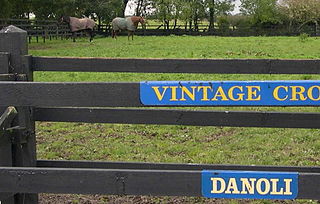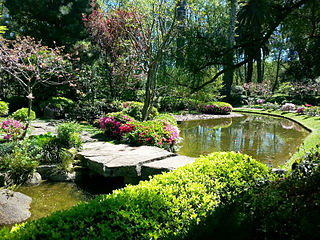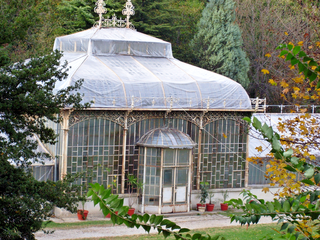 W
WJapanese gardens are traditional gardens whose designs are accompanied by Japanese aesthetics and philosophical ideas, avoid artificial ornamentation, and highlight the natural landscape. Plants and worn, aged materials are generally used by Japanese garden designers to suggest an ancient and faraway natural landscape, and to express the fragility of existence as well as time's unstoppable advance. Ancient Japanese art inspired past garden designers.
 W
WThe Smith-Ransome Japanese Bridge of South Ferry Hills on Shelter Island, New York is one of the first 'reinforced concrete construction' structures built in North America by engineer Ernest L. Ransome for the mineral prospector known as the "Borax King", Francis Marion Smith. Installed in the late 19th century at Smith's East Coast estate, 'Presdeleau', it is an example of ferro-concrete construction enabling an elegant design of what was a popular early 20th century period piece, the Japanese style bridge. It is listed on the New York State and National Register of Historic Places as a significant historical landmark and one of the last surviving two by Ernest Ransome.
 W
WThe Dunedin Botanic Garden is located at the northern end of central Dunedin, in the South Island of New Zealand. The garden is close to the University of Otago and one of the city's most historic cemeteries, the Northern Cemetery, on a spur of Signal Hill and on the river plain immediately below it.
 W
WThe Fondation Claude Monet is a nonprofit organisation that runs and preserves the house and gardens of Claude Monet in Giverny, France, where Monet lived and painted for 43 years. Monet was inspired by his gardens, and spent years transforming them, planting thousands of flowers. He believed that it was important to surround himself with nature and paint outdoors. He created many paintings of his house and gardens, especially of water lilies in the pond, the Japanese bridge, and a weeping willow tree.
 W
WThe Irish National Stud is a Thoroughbred horse breeding facility in Tully, Kildare, County Kildare, Ireland. It was formally established by incorporation on 11 April 1946 under the National Stud Act, 1945 and is owned by the Irish Government.
 W
WThe Japanese Garden is a municipal park on the Avenue Princesse Grace, in the Larvotto ward of Monaco. It is next to the Grimaldi Forum convention centre. The garden is 0.7 hectares in size, and features a stylised mountain, hill, waterfall, beach, brook, and a Zen garden for meditation. It is open daily from 9:00 to sunset.
 W
WThe Japanese Garden of Montevideo is located in the Prado neighbourhood of Montevideo, behind the Juan Manuel Blanes Museum.
 W
WJapanese Garden is a park and garden located in Jurong East, Singapore, covering 13.5 hectares (135,000 m2) of land.
 W
WWrocław's Japanese Garden was founded in the years 1909–1913 as an exotic garden for the Centennial Exhibition. It is located in the Śródmieście district of Wrocław, in the boundaries of Szczytnicki Park, near the Centennial Hall. It is home to almost 270 taxa of woody plants, as well as 78 species of Asian plants, of which 38 are endemic to Japan, such as Styrax japonicus. It is an important landmark of Wrocław.
 W
WThe Jevremovac Botanical Garden is the botanical garden of the University of Belgrade and also a surrounding urban neighborhood of Belgrade, Serbia. The garden is located in Belgrade's municipality of Stari Grad and is an administered by the University of Belgrade's Biology School.
 W
WLauriston Castle is a 16th-century tower house with 19th-century extensions overlooking the Firth of Forth, in Edinburgh, Scotland. It lies on Cramond Road South, between Cramond, Davidson's Mains, and Silverknowes. The substantial grounds, Lauriston Castle Gardens, operate as a local park. The castle was bequeathed to the Edinburgh Corporation and hosts the Lord Provost's annual Garden Party. The house is a Category A listed building and the grounds are included in the Inventory of Gardens and Designed Landscapes in Scotland.
 W
WThe Parc Oriental de Maulévrier is a Japanese garden located in Maulévrier, Maine-et-Loire, Pays de la Loire, France. It is open daily except Monday in the warmer months; an admission fee is charged.
 W
WShirenewton Hall, originally Shirenewton Court, is a country house and estate adjoining the village of Shirenewton, Monmouthshire, Wales, about 3 miles (4.8 km) west of Chepstow. The 29.5-acre (11.9 ha) estate is located on a hillside, and commands views across the "Golden Valley" to the west and the Severn estuary in the south.
 W
WIn Japan, a tōrō is a traditional lantern made of stone, wood, or metal. Like many other elements of Japanese traditional architecture, it originated in China where they can still be found in Buddhist temples and Chinese gardens. They are not as common in Korea as they are in China or Japan. In Japan, tōrō were originally used only in Buddhist temples, where they lined and illuminated paths. Lit lanterns were then considered an offering to Buddha. Their use in Shinto shrines and also private homes started during the Heian period (794–1185).
 W
WA tsubo-niwa (坪庭/壷庭/つぼにわ) is a type of very small garden in Japan. The term "tsuboniwa" stems from tsubo (坪), a unit of measurement, and "niwa", meaning "garden". Other spellings of tsubo-niwa translate to "container garden", and a tsubo-niwa may differ in size from the tsubo unit of measurement.